Lumapit Sa Akin, Paraiso
Keywords: Alexander Iadarola, come, filipina, film, immigration, Interview, paradise, stephanie comilang, tobias lee, why be
A science fiction documentary about Filipina migrant workers in Hong Kong
Filipina-Canadian filmmaker Stephanie Comilang’s new film Lumapit Sa Akin, Paraiso (Come to Me, Paradise) indirectly takes as its subject the increasingly documented struggle of migrant Filipina domestic workers in Hong Kong, whose occupation is characterized by rampant conditions of forced labor, exploitation, and human trafficking. Whereas some documentary filmmaking offers a fetishistic representation of its subjects’ exploitation, in turn adding to their dehumanization, Comilang’s account relays an intimate and complex account of the domestic workers’ everyday lives. To that effect, it’s a deft mixture of science fiction and documentary, employing a tone that’s equal measures dissociative, casual, and understatedly spiritual, telling a story about the women’s ritual of digitally transmitting their stories and memories back to the Philippines at the end of each workweek.
Much of its footage comes from a drone called Paradise, who not only serves as the film’s poetically-inclined narrator, but also as the vessel by which the community of Filipina domestic workers transmit their messages back home. Voiced by the director’s mother Emily Comilang, who migrated to Canada from the Philippines in the ‘70s, Paradise’s character enacts and embodies a fluid constellation of themes including community, diaspora, and memory. She is one and the same as the women, linked to them by what appears to be a telepathically networked, collective consciousness. At the same time, she mediates and symbolizes their idea of paradise as home, positioned as a middle ground between the Philippines and Hong Kong, neither fully here nor there.

Stephanie Comilang, Lumapit Sa Akin, Paraiso film still.
Interspersed throughout Lumapit Sa Akin, Paraiso’s narrative is an assemblage of cellphone videos, YouTube vlog excerpts, and staged scenes featuring three domestic workers named Irish May Salinas, Lyra Ancheta Torbela, and Romylyn Presto Sampaga. In these clips, Irish takes selfies, sings a karaoke version of Justin Bieber’s “Love Yourself,” and conducts interviews with the women about working life, relationships with families, and dating as they move through Hong Kong’s urban space.
In the latter scenes, the setting is Central, the city’s business district. Because they are legally forced to live with their employers, the community of domestic workers uses their day off on Sunday to congregate from across the city and occupy huge swathes of public space demarcated with cardboard architecture. There, they set up temporary, informal domestic areas designed for eating, praying, exercising, and collective self-care, combating what Rhacel Salazar Parreñas calls their placelessness and exclusion from dominant culture. By innovating and implementing this urban and social technology, they alter the morphology of their surroundings to forge a communal sense of belonging out of nonbelonging. Indeed, these constructions share a status of in-betweenness with the drone and all that it indexes.
Lumapit Sa Akin, Paraiso’s soundtrack is produced and assembled by Berlin and Copenhagen-based producer Why Be, née Tobias Lee, who recently contributed another soundtrack to CUSS Group’s “Triomf Factory Shop” installation at the 9th Berlin Biennale, curated by DIS. Released by African diasporic collective NON WORLDWIDE and featuring collaborations with Elysia Crampton and SKY H1, Lee’s work on Comilang’s film finds the artist working in his practiced compositional style, characterized by slow accumulation of debris dragged with intentionality yet vigorously without univocal direction. Where the stickiness of the film’s emotional tenor generally arrives by way of subtle, contagiously harmonic mutual resonances within a carefully arranged narrative, Lee’s contribution on its own is a little less plotted, more of a free fall or jam session along vectors of internal affective intuition.
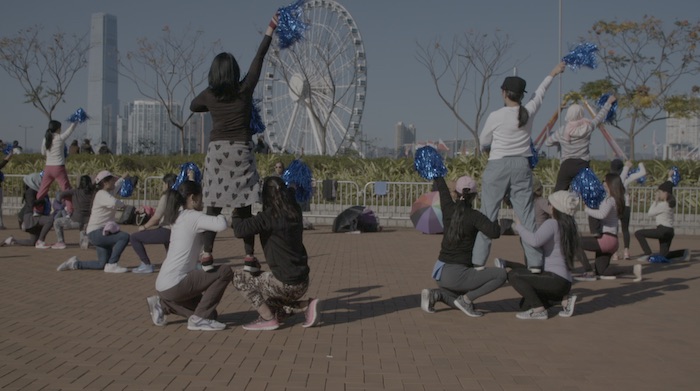
Stephanie Comilang, Lumapit Sa Akin, Paraiso film still.
His 2015 EP Snipestreet engaged the theme of tenderness by conveying a sense of picking at an open wound; that arrives again here, but it’s transmuted to a very different register. In this context, tenderness flows through the work in its disarming sense of gracefully resilient duration, moving slowly and hoveringly through sweet curdling and contrailing. Tonally, it marks something of a left turn for the producer, discarding previous smatterings of abrupt punctuation in favor of a slower and more extended sense of time, dangled loose by way of fuzzily glowing, soft synth arrangements.
Alexander Iadarola: What were your conversations like as collaborators during the production of the film?
Tobias Lee: It was very important that we agreed on a weird overall idea, so I could still do what I do without having to change what [my own approach] too much, and at the same time Stephanie could get something that she could relate to. Part of that was that she actually brought me to Hong Kong while shooting it, so I could actually meet these people and have a deep understanding of the film.
Stephanie Comilang: I thought it was important that whoever was making sound for the film come and see what was happening, because the film is based on a reality. I wasn’t sure how much it would really influence how he would make the music but I didn’t really care. That wasn’t really the point. It was more like I just wanted that person to be there and see it.
Tobias, when you first reached out about this project I was surprised to see that you had done a film soundtrack. The last time we talked, you were pretty emphatic about not wanting your work to be connected to anything besides pure emotion, avoiding political, social, or ideological influence of any kind. Here, though, you’re working on a part-documentary film with an ethical stance, exploring a form of resistance to highly exploitative labor conditions.
T: What really sold me on this one was the overall theme of the movie,which is how women get treated beacuse of social structures in Asia.
Because Korean adoption in the 80s, which I’m a product of, was mainly a result of deep traditional slut shaming (which is an issue in many Asian countries) that would make it socially as well as financially impossible to be a single mom, the whole theme about this huge Filipina colony of migrant workers, and how they were being mistreated, somehow moved something deep inside me.
I rarely choose work for social or political reasons but this touched me and I wanted to be a part of this project and do the women justice somehow. It makes me sick to see how Asian females are being treated/talked to in Western countries but the fact that it can be just as dark and even more degrading in Asia troubles me a lot, especially ‘cause I am so caught in between those two worlds and am confused and frustrated with both of them. This was my shot at contributing to this dialogue, ‘though it all of a sudden feels very irrelevant to be a musician when you dip into this world.

Stephanie Comilang, Lumapit Sa Akin, Paraiso film still.
S: Part of the reason I wanted to work with Tobias was kind of the same idea. The film is about how people are forced to move around the world because of circumstances in their own country that they can’t really avoid. The reasons behind why people move and why they’re forced to move, and then what happens when they’re in the new country, how they adapt to or affect it.
My crew is really small, but the people that I hired, it was a conscious decision to hire people who had been affected by that somehow. My cinematographer [Iris Ng] is a Hong Kong Chinese woman who lives in Canada, whose parents went to Canada in the ’70s and ’80s. Everyone who worked on the film somehow connected to that theme in a way.
What went into creating the drone character? I was struck by how it had this cyborgian or post-human hybridity but also enacted a liminal site between upload and download, as conveyor of messages and prosthetic memory retainer. It’s simultaneously between Hong Kong and the Philippines, here and there at once…
S: I knew I wanted the drone character to be narrated by my mother, who again is tied into the same idea as the film. She came to Canada in the ’70s because of Marcos in the Philippines. I just thought that her voice, being my mother, made sense in the film process.
I didn’t really know how I wanted to structure the film when I started it, but by the end I thought that creating a character for Paradise, the drone, made a lot of sense. She’s able to send all the women’s videos and messages from the week back home, but the messages are also the way that she’s feeling, the way she shares the same identity that the women have, which is one of isolation and longing. You can hear that in the way that she speaks.

Stephanie Comilang, Lumapit Sa Akin, Paraiso film still.
In terms of thinking through the machine-human relationship in the film, did that just emerge of its own accord or was there a concise thought process behind it?
S: I knew I wanted to shoot on cellphones and use the women [for that]. I spent a month there last year doing initial research, just trying to flush out the complexities of it there, talking to NGOs and the women themselves, and when I was walking around looking at how the women spent their Sundays, everyone was on their phone. That was their one thing that they used to communicate with the outside world, home, and with each other.
A lot of them are creating vlogs. That’s how I met one of the women in the film initially, she had her own YouTube channel. Irish is her name, and she ended up being my main contact with the rest of the women there. I contacted her on YouTube, because I was watching a bunch of her videos. They were just kind of showing her everyday life. One of those videos is actually used in the film.
[At one point I wondered] what would be a counterpoint into cellphones, because they are really personal and interior. Something that was the opposite of that was the drone because it looked from above.
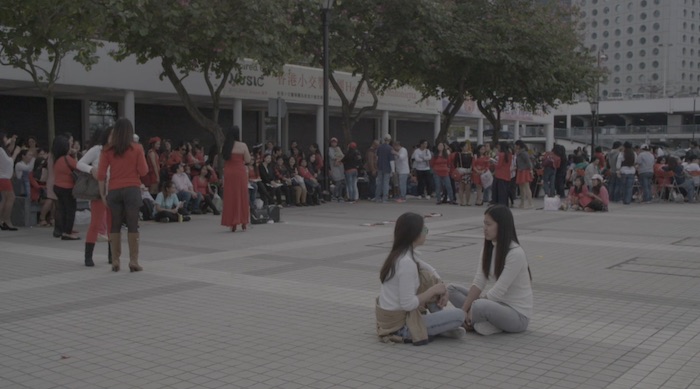
Stefanie Comilang, Lumapit Sa Akin, Paraiso film still.
What were your conversations with the women in the film like?
S: I told them I was making a documentary but there would also be elements of science fiction. A lot of it would be staged. I told them I wanted them to shoot some things on the camera, film things that they would do on their own, stuff at home, things that they were doing already. I told them a bit about where I came from and where my parents are from. They were sort of down for whatever, they’re really cool. Irish was a journalism major, so she already was doing interviews on the street with other women so those interviews that you saw in the film were what she had already done from her YouTube channel.
What did you think, Tobias, when you saw these women’s spaces in Hong Kong for the first time?
T: Our conversation was about comparing them to aliens, and this idea that they came there and built cardboard pods like aliens would. For the soundtrack, I asked Chino [Amobi] for his favorite sci-fi soundtracks and then I listened to every one of them for two months because I wanted to treat this like a sci-fi movie, with the idea was that they were aliens who came to this other planet and built spaces.
What about the affect or kind of expressivity of sci-fi soundtracks worked so well with this film? Obviously the reality it deals with is kind of a sci-fi scenario in itself, as you described it.
T: What sci-fi soundtracks mostly do is somehow represent something that’s super otherworldly/foreign/not-that-intimate and at the same time they’re supposed to resemble something very intimate, very relatable in the greater scheme. There was the real challenge: to make the film sound otherworldly but at the same time give it a sensitivity that was still emotional or intimate.
That’s really where most sci-fi soundtracks that I listened to went wrong, is that they just sounded otherworldly. You can easily make music sound very alienated and not very relatable, but the key is to still make it super soft.
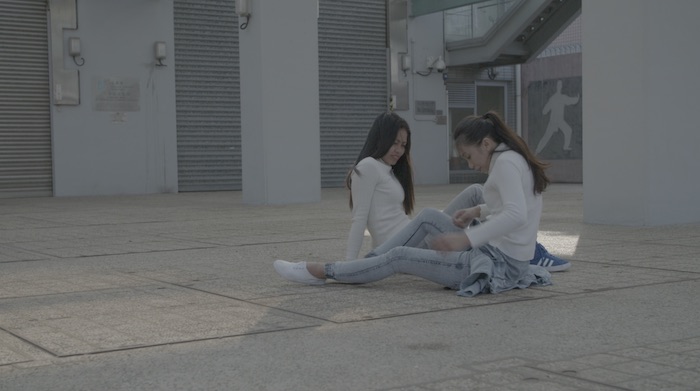
Stephanie Comilang, Lumapit Sa Akin, Paraiso film still.
S: Sci-fi [as a genre] always has the same sort of idea—that’s also why I wanted to make the film. It’s people who are within the society looking at these outsiders, minority groups, and excluding them because of some sort of thing. They’re scared of them. The minorities usually have some sort of power that the others don’t have, and they’re pushed to the side or the outside. That theme translates really well to the migrant, immigrant experience.
This simultaneous intimacy and alienation you’re talking about, Tobias, plays on a theme of cross-contaminated polarities that seems to be very active in the film in general. Along these lines, the feminist architecture the women in the film create in a way really inverts their peripheralization in Hong Kong along the lines of race and class. They’re normally on the margins, forced by law to stay in their employers homes, but here they are in the city center, collectively occupying huge swathes of space.
S: Completely. They’re marginalized women who are trying to just create their own space and they’re doing it within basically the most expensive spots in Hong Kong, which is a crazy thing. The Hong Kong government tried to eradicate them but it didn’t work. Especially the Filipina community, they’re really mobilized and they have their shit together. They protest all the time. They speak English so communication is really tight. They have their voice already. They’ve been around for a long time there, whereas the Indonesian women haven’t been there as long as the Filipinas. There’s a lot of organizations, and I think it’s getting stronger because there is more media attention being brought to what’s happening.
There was a case last year from this young Indonesian woman [named Erwiana Sulistyaningsih] who was beat just almost to death. She was so bad, her employer drove her to the airport and basically threw her into the airport, and she could barely walk. Other women had to help her to the plane. When she got back to Indonesia, her family saw she lost 25 kilos. When she went to Hong Kong, she was 50 kilos. Her employer burnt her hands and she was just in complete … She was almost dead basically.
I was there for the case and the hearing in February [2015]. The international media finally paid attention and that made what’s happening there more of an issue now. It was just last year and that shit’s been happening forever. There’s so many suicides from women there. There’s so much undocumented shit because the women don’t have any agency there.
One of the huge things is that by law, they have to live with their employer, which is fucked up. This means that the space for them to be treated like a slave is huge. If you don’t have your own privacy, if you can’t live outside the [employer’s home], then you’re made to work 24/7. On their day off Sunday, they want to leave the house. There’s also no regulation. No one really checks up on the women.
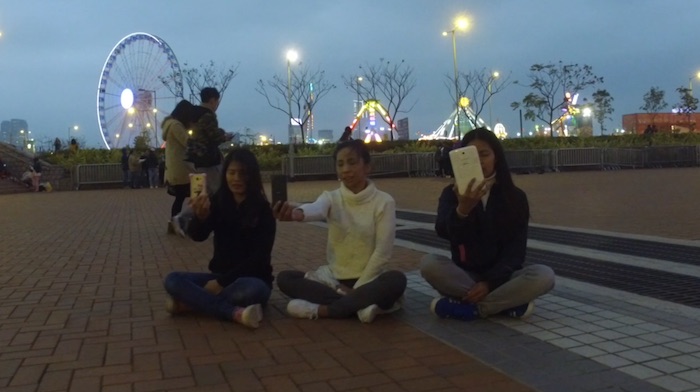
Stephanie Comilang, Lumapit Sa Akin, Paraiso film still.
Part of what’s interesting about the spaces these women create is that a lot of the things they do there—eat, groom, pray, dance, exercise—are domestic activities. They’re projecting and creating another sense of domestic life in the most unlikely of places.
S: It’s everything that you would just do at home. I see a lot of women in the cardboard just laying down on their phones, which is exactly what I would do. They don’t want to be at home because why would they want to be at home with their employer asking them to do shit. A lot of them don’t have their own rooms. They’re just sleeping on the couch or the floor. It’s much better to be in these other spaces that they can create on their own, and have their own agency there.
Rhacel Salazar Parreñas, who has done a lot of academic work on Filipina migrant workers, has written that compared to other migrant communities, they have ambivalent settlement desires—less willingness to settle permanently.
S: They don’t want to live in Hong Kong. A lot of them want to go back. They’re just trying to make money to put their family through school and help their parents. Then a lot of them go home and take that money and open a business or buy a property. I think that’s pretty true for everyone there. It’s a temporary thing, a temporary living situation. A lot of them don’t want to live there because living there is fucking hard, so expensive. You would never be able to buy property there, like no way. People from there can’t even buy.
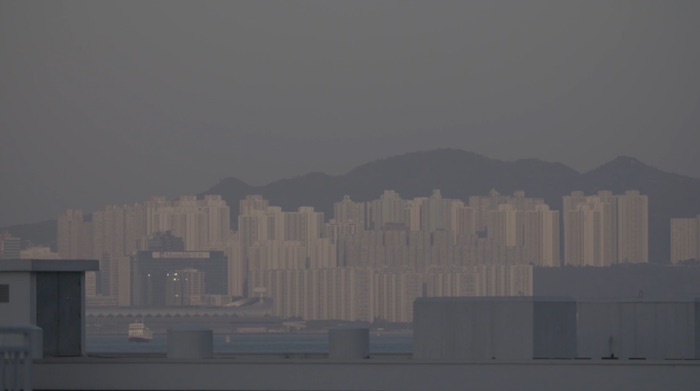
Stephanie Comilang, Lumapit Sa Akin, Paraiso film still.
I’m curious what felt right to you about the narrative strategy you chose—kind of documentary, kind of sci-fi, very everyday, slightly playful. In other words, very much not how this subject would normally be covered, but arguably creating something truer to the complex reality of these women’s lives because of that.
S: I knew that I wanted to make something around how the women hang out, how they spend their leisure time and I didn’t want to make it apparent necessarily what these women did. I didn’t really want to focus on talking to the women about how shitty it is there. That was maybe the main point for me. It was more about focusing on a day in the life.
Tobias, what made NON the right outlet for this soundtrack?
T: The reason with NON was that they were one of the only labels run by friends that I haven’t done anything with before, and the whole idea about NON is to give people a voice that usually don’t have a voice. They kind of fit perfectly with the whole theme of this movie.
I tend to think about your work as an accumulation of debris over time. What was your process for composing this score? How did you reconcile your usual, strictly visceral approach with a structured storyline?
T: The process was definitely being there and getting a vibe. However the soundtrack built itself was only because of the stuff I saw there, and conversations with Stephanie. A lot of it really came about really just by me jamming certain emotions out. Any deeper aesthetic to that, I have no idea to be honest.
Which was a very new, very project-oriented approach which I felt like I had to try out since this is not only about me. I’m not used to taking other people’s opinions into consideration.

Stephanie Comilang, Lumapit Sa Akin, Paraiso film still.
Why did that end up being okay in the scenario?
T: Definitely because there was a greater purpose than just what I thought. Everything up to this point has been about my taste or idea about what the world is, but this actually served a greater purpose, something above me and something that was not initiated by me. That made me treat it a lot differently than I usually would and maybe accept a lot of situations I usually wouldn’t.
What’s the higher thing?
T: The higher thing is that these women that we portrayed in this film are dealing with 10,000 more problems than I have ever had in my entire life, and that I was blessed enough to go there and dip into that for like two weeks and then go back to my traveling musician life and be a brat about that. But they are still there doing their thing, I only got a whiff of it. That is the greater purpose, to do these women justice because this is their life.
That sense of extended temporality definitely comes through in the tracks. The last EP was full of abrupt punctuation, but this feels like a slower and more extended sense of time. Stephanie, what is the paradise that the film’s title refers to?
S: I think it’s their home, really. You see it at the beginning and at the end of the film with the hills, that’s this spot in Philippines called Bohol. It used to be undersea—it’s a build up of coral that formed into these hills somehow.
I met my parents there after shooting in Hong Kong and we took a trip there. I had seen it in pictures but it looked like this crazy alien landscape, like Avatar. It really looked utopian to me. The idea was that the women come from this place and they live beneath these hills, and that’s where their community, that’s where they’re from initially. In a way, that was kind of like paradise, along with the character Paradise, she’s also paradise.
Tobias, is home as a theme or reality meaningful for you as an artist?
T: Home for me is kind of funny—I definitely feel conflicted about that already in a way. I could relate to this idea about these women going somewhere to really build a space for themselves. There, they did it out of cardboard, and [I connect that to] how I would try to do it in a lot of other places.
A screening of Lumapit Sa Akin Paraiso will be held at Asia Art Archive in America on August 5th at 7pm.

Stephanie Comilang, Lumapit Sa Akin, Paraiso film still.